Wireless Networking: Antenna, Protocols, and Challenges
VerifiedAdded on 2023/06/10
|8
|1997
|228
Report
AI Summary
This report provides a comprehensive overview of wireless networking concepts, beginning with an explanation of antennas, including Yagi-Uda, horn, and cellular antennas, detailing their advantages and disadvantages. It then explores various wireless network protocols, such as Wi-Fi, Bluetooth, and ZigBee, highlighting their applications, advantages, and disadvantages. The report also discusses the challenges faced by wireless networks, particularly concerning security, and explores the role of software-defined wireless networks in addressing these issues. A reflection on related research papers is included, further analyzing the challenges and potential solutions in the field of wireless networking. The report emphasizes the importance of data encryption and software-defined networking in improving security and quality of service in wireless communication. Finally, the report concludes by summarizing the key findings and insights into the evolving landscape of wireless networking.

Running Head: WIRELESS NETWORKING CONCEPTS
0
Wireless Networking Concepts
0
Wireless Networking Concepts
Paraphrase This Document
Need a fresh take? Get an instant paraphrase of this document with our AI Paraphraser
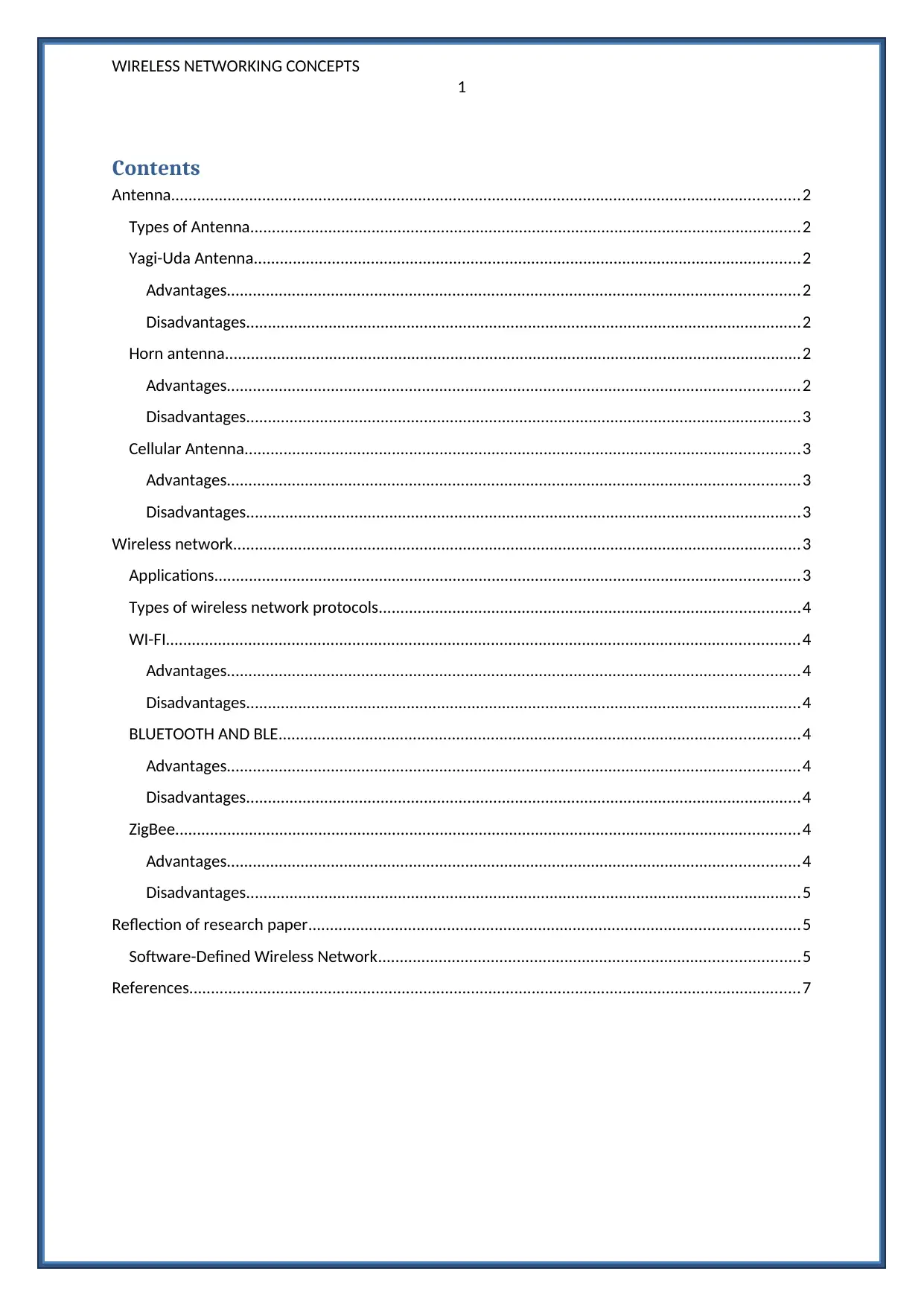
WIRELESS NETWORKING CONCEPTS
1
Contents
Antenna.................................................................................................................................................2
Types of Antenna...............................................................................................................................2
Yagi-Uda Antenna..............................................................................................................................2
Advantages....................................................................................................................................2
Disadvantages................................................................................................................................2
Horn antenna.....................................................................................................................................2
Advantages....................................................................................................................................2
Disadvantages................................................................................................................................3
Cellular Antenna................................................................................................................................3
Advantages....................................................................................................................................3
Disadvantages................................................................................................................................3
Wireless network...................................................................................................................................3
Applications.......................................................................................................................................3
Types of wireless network protocols.................................................................................................4
WI-FI..................................................................................................................................................4
Advantages....................................................................................................................................4
Disadvantages................................................................................................................................4
BLUETOOTH AND BLE........................................................................................................................4
Advantages....................................................................................................................................4
Disadvantages................................................................................................................................4
ZigBee................................................................................................................................................4
Advantages....................................................................................................................................4
Disadvantages................................................................................................................................5
Reflection of research paper.................................................................................................................5
Software-Defined Wireless Network.................................................................................................5
References.............................................................................................................................................7
1
Contents
Antenna.................................................................................................................................................2
Types of Antenna...............................................................................................................................2
Yagi-Uda Antenna..............................................................................................................................2
Advantages....................................................................................................................................2
Disadvantages................................................................................................................................2
Horn antenna.....................................................................................................................................2
Advantages....................................................................................................................................2
Disadvantages................................................................................................................................3
Cellular Antenna................................................................................................................................3
Advantages....................................................................................................................................3
Disadvantages................................................................................................................................3
Wireless network...................................................................................................................................3
Applications.......................................................................................................................................3
Types of wireless network protocols.................................................................................................4
WI-FI..................................................................................................................................................4
Advantages....................................................................................................................................4
Disadvantages................................................................................................................................4
BLUETOOTH AND BLE........................................................................................................................4
Advantages....................................................................................................................................4
Disadvantages................................................................................................................................4
ZigBee................................................................................................................................................4
Advantages....................................................................................................................................4
Disadvantages................................................................................................................................5
Reflection of research paper.................................................................................................................5
Software-Defined Wireless Network.................................................................................................5
References.............................................................................................................................................7
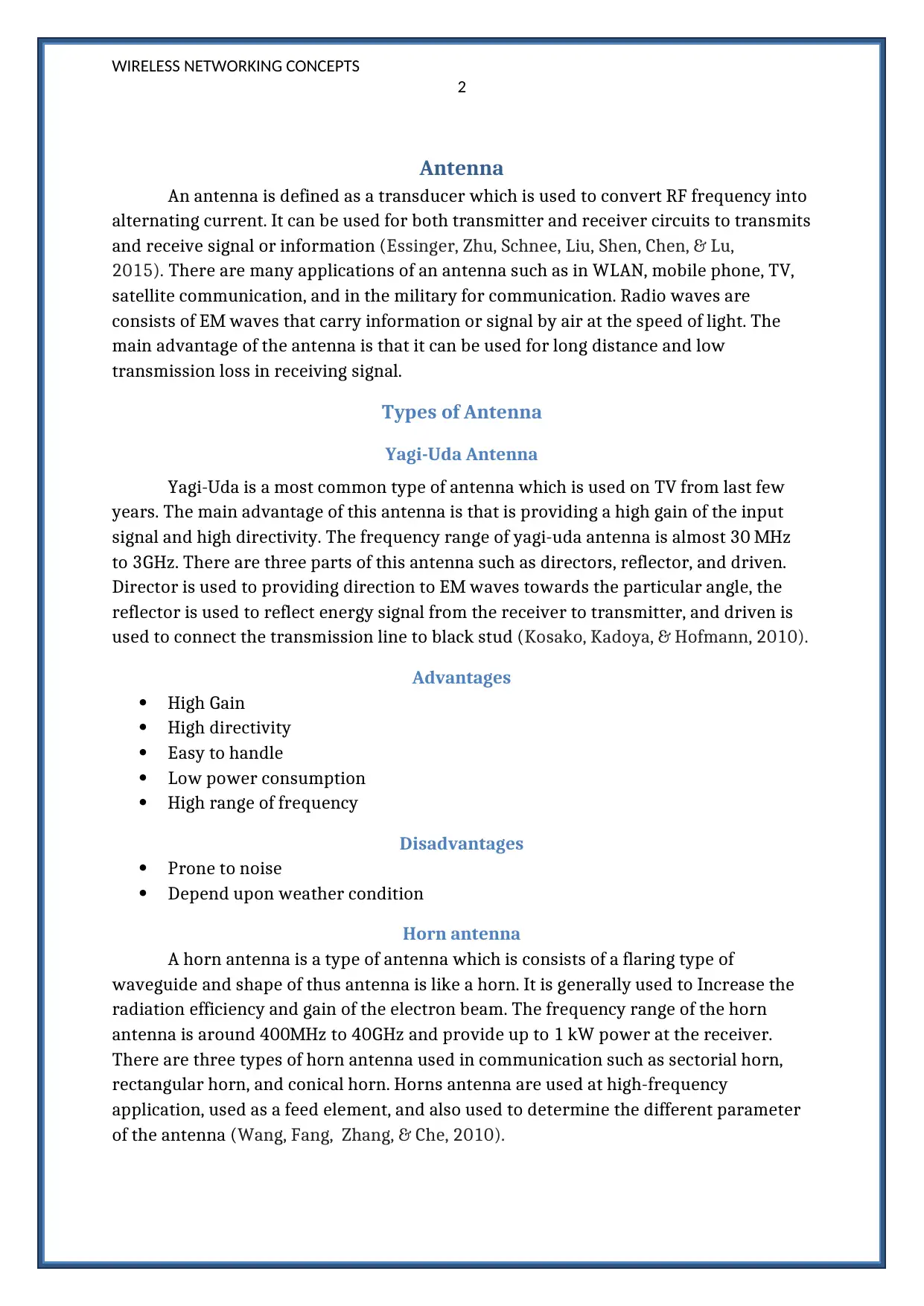
WIRELESS NETWORKING CONCEPTS
2
Antenna
An antenna is defined as a transducer which is used to convert RF frequency into
alternating current. It can be used for both transmitter and receiver circuits to transmits
and receive signal or information (Essinger, Zhu, Schnee, Liu, Shen, Chen, & Lu,
2015). There are many applications of an antenna such as in WLAN, mobile phone, TV,
satellite communication, and in the military for communication. Radio waves are
consists of EM waves that carry information or signal by air at the speed of light. The
main advantage of the antenna is that it can be used for long distance and low
transmission loss in receiving signal.
Types of Antenna
Yagi-Uda Antenna
Yagi-Uda is a most common type of antenna which is used on TV from last few
years. The main advantage of this antenna is that is providing a high gain of the input
signal and high directivity. The frequency range of yagi-uda antenna is almost 30 MHz
to 3GHz. There are three parts of this antenna such as directors, reflector, and driven.
Director is used to providing direction to EM waves towards the particular angle, the
reflector is used to reflect energy signal from the receiver to transmitter, and driven is
used to connect the transmission line to black stud (Kosako, Kadoya, & Hofmann, 2010).
Advantages
High Gain
High directivity
Easy to handle
Low power consumption
High range of frequency
Disadvantages
Prone to noise
Depend upon weather condition
Horn antenna
A horn antenna is a type of antenna which is consists of a flaring type of
waveguide and shape of thus antenna is like a horn. It is generally used to Increase the
radiation efficiency and gain of the electron beam. The frequency range of the horn
antenna is around 400MHz to 40GHz and provide up to 1 kW power at the receiver.
There are three types of horn antenna used in communication such as sectorial horn,
rectangular horn, and conical horn. Horns antenna are used at high-frequency
application, used as a feed element, and also used to determine the different parameter
of the antenna (Wang, Fang, Zhang, & Che, 2010).
2
Antenna
An antenna is defined as a transducer which is used to convert RF frequency into
alternating current. It can be used for both transmitter and receiver circuits to transmits
and receive signal or information (Essinger, Zhu, Schnee, Liu, Shen, Chen, & Lu,
2015). There are many applications of an antenna such as in WLAN, mobile phone, TV,
satellite communication, and in the military for communication. Radio waves are
consists of EM waves that carry information or signal by air at the speed of light. The
main advantage of the antenna is that it can be used for long distance and low
transmission loss in receiving signal.
Types of Antenna
Yagi-Uda Antenna
Yagi-Uda is a most common type of antenna which is used on TV from last few
years. The main advantage of this antenna is that is providing a high gain of the input
signal and high directivity. The frequency range of yagi-uda antenna is almost 30 MHz
to 3GHz. There are three parts of this antenna such as directors, reflector, and driven.
Director is used to providing direction to EM waves towards the particular angle, the
reflector is used to reflect energy signal from the receiver to transmitter, and driven is
used to connect the transmission line to black stud (Kosako, Kadoya, & Hofmann, 2010).
Advantages
High Gain
High directivity
Easy to handle
Low power consumption
High range of frequency
Disadvantages
Prone to noise
Depend upon weather condition
Horn antenna
A horn antenna is a type of antenna which is consists of a flaring type of
waveguide and shape of thus antenna is like a horn. It is generally used to Increase the
radiation efficiency and gain of the electron beam. The frequency range of the horn
antenna is around 400MHz to 40GHz and provide up to 1 kW power at the receiver.
There are three types of horn antenna used in communication such as sectorial horn,
rectangular horn, and conical horn. Horns antenna are used at high-frequency
application, used as a feed element, and also used to determine the different parameter
of the antenna (Wang, Fang, Zhang, & Che, 2010).
⊘ This is a preview!⊘
Do you want full access?
Subscribe today to unlock all pages.

Trusted by 1+ million students worldwide
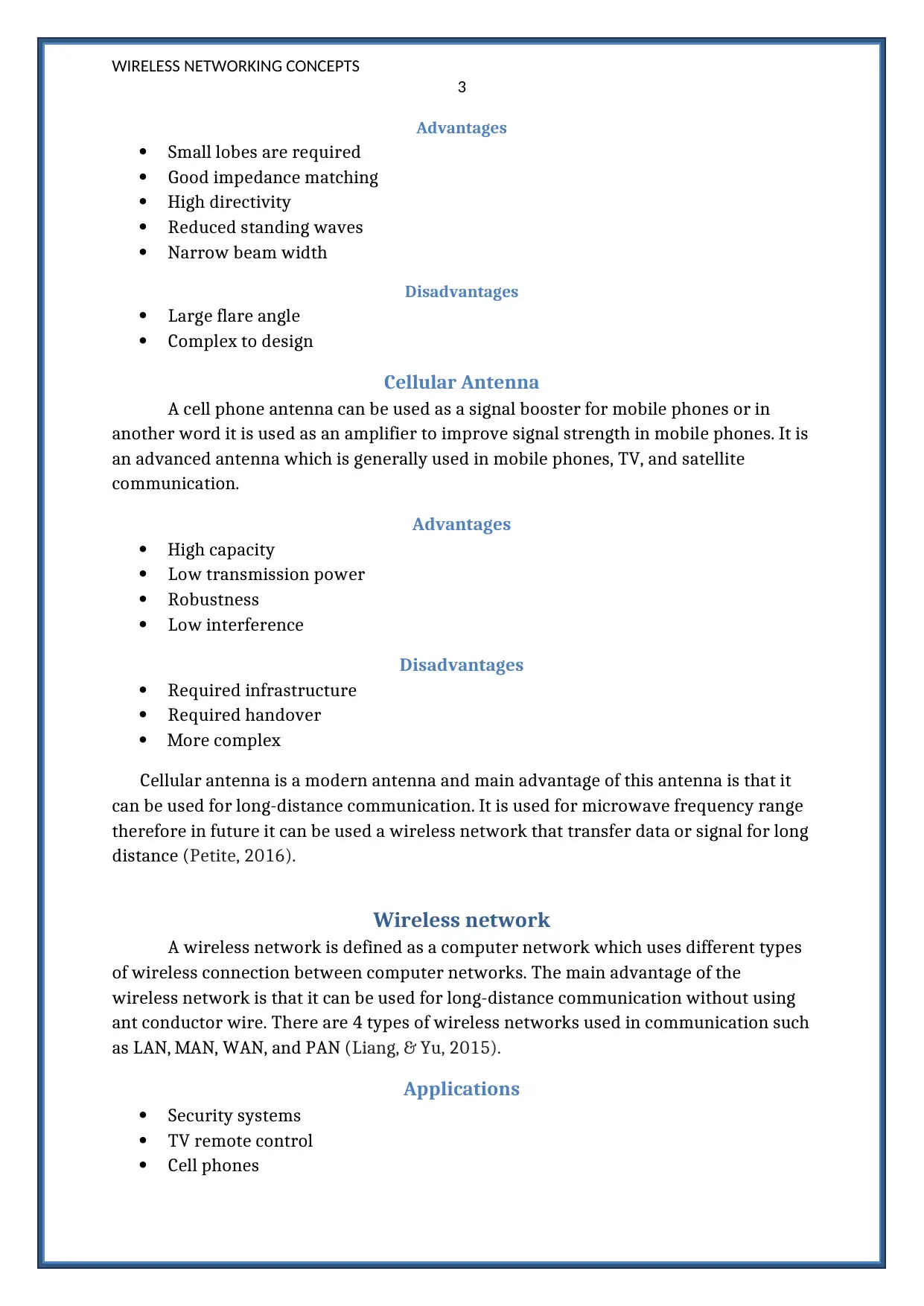
WIRELESS NETWORKING CONCEPTS
3
Advantages
Small lobes are required
Good impedance matching
High directivity
Reduced standing waves
Narrow beam width
Disadvantages
Large flare angle
Complex to design
Cellular Antenna
A cell phone antenna can be used as a signal booster for mobile phones or in
another word it is used as an amplifier to improve signal strength in mobile phones. It is
an advanced antenna which is generally used in mobile phones, TV, and satellite
communication.
Advantages
High capacity
Low transmission power
Robustness
Low interference
Disadvantages
Required infrastructure
Required handover
More complex
Cellular antenna is a modern antenna and main advantage of this antenna is that it
can be used for long-distance communication. It is used for microwave frequency range
therefore in future it can be used a wireless network that transfer data or signal for long
distance (Petite, 2016).
Wireless network
A wireless network is defined as a computer network which uses different types
of wireless connection between computer networks. The main advantage of the
wireless network is that it can be used for long-distance communication without using
ant conductor wire. There are 4 types of wireless networks used in communication such
as LAN, MAN, WAN, and PAN (Liang, & Yu, 2015).
Applications
Security systems
TV remote control
Cell phones
3
Advantages
Small lobes are required
Good impedance matching
High directivity
Reduced standing waves
Narrow beam width
Disadvantages
Large flare angle
Complex to design
Cellular Antenna
A cell phone antenna can be used as a signal booster for mobile phones or in
another word it is used as an amplifier to improve signal strength in mobile phones. It is
an advanced antenna which is generally used in mobile phones, TV, and satellite
communication.
Advantages
High capacity
Low transmission power
Robustness
Low interference
Disadvantages
Required infrastructure
Required handover
More complex
Cellular antenna is a modern antenna and main advantage of this antenna is that it
can be used for long-distance communication. It is used for microwave frequency range
therefore in future it can be used a wireless network that transfer data or signal for long
distance (Petite, 2016).
Wireless network
A wireless network is defined as a computer network which uses different types
of wireless connection between computer networks. The main advantage of the
wireless network is that it can be used for long-distance communication without using
ant conductor wire. There are 4 types of wireless networks used in communication such
as LAN, MAN, WAN, and PAN (Liang, & Yu, 2015).
Applications
Security systems
TV remote control
Cell phones
Paraphrase This Document
Need a fresh take? Get an instant paraphrase of this document with our AI Paraphraser
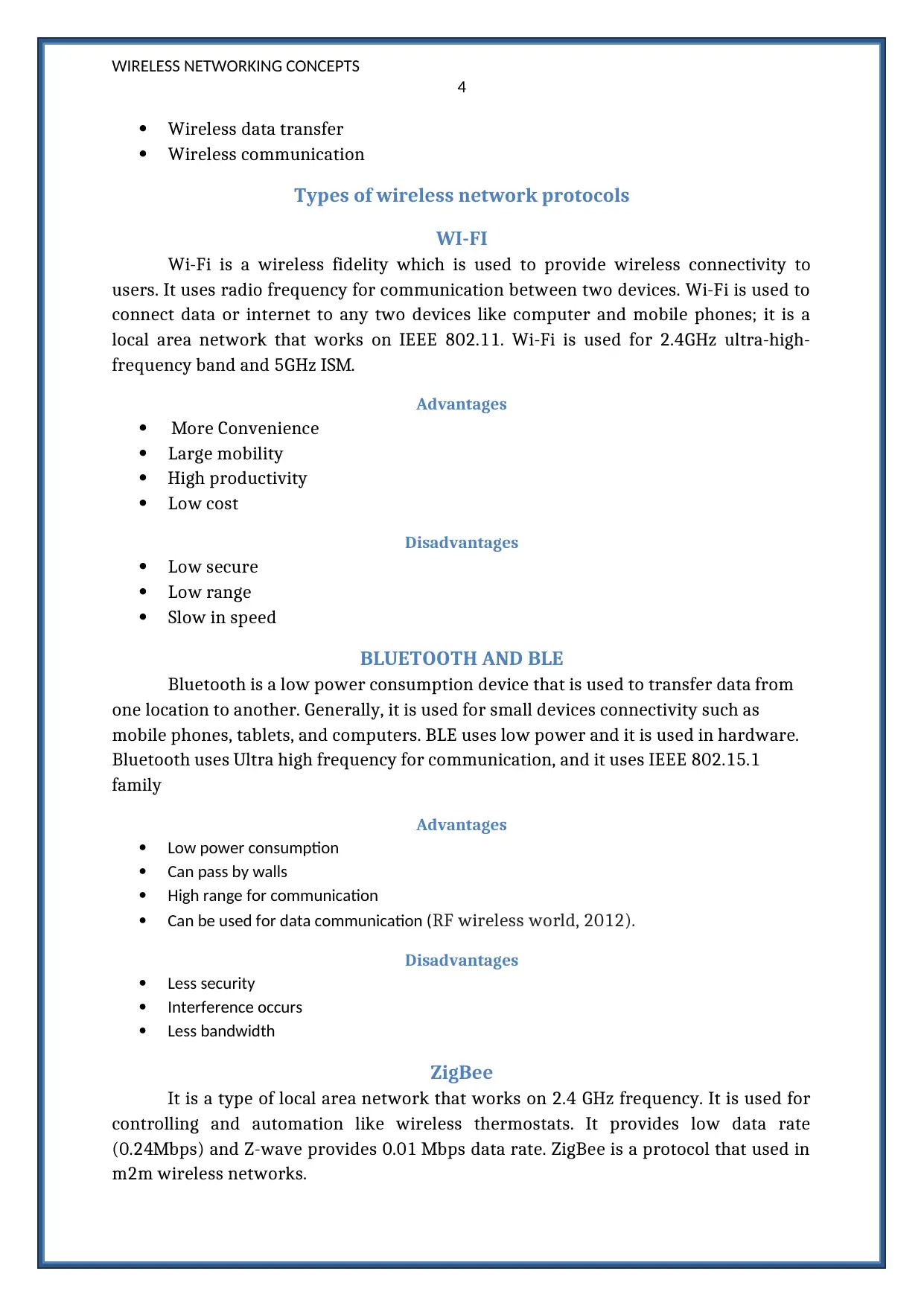
WIRELESS NETWORKING CONCEPTS
4
Wireless data transfer
Wireless communication
Types of wireless network protocols
WI-FI
Wi-Fi is a wireless fidelity which is used to provide wireless connectivity to
users. It uses radio frequency for communication between two devices. Wi-Fi is used to
connect data or internet to any two devices like computer and mobile phones; it is a
local area network that works on IEEE 802.11. Wi-Fi is used for 2.4GHz ultra-high-
frequency band and 5GHz ISM.
Advantages
More Convenience
Large mobility
High productivity
Low cost
Disadvantages
Low secure
Low range
Slow in speed
BLUETOOTH AND BLE
Bluetooth is a low power consumption device that is used to transfer data from
one location to another. Generally, it is used for small devices connectivity such as
mobile phones, tablets, and computers. BLE uses low power and it is used in hardware.
Bluetooth uses Ultra high frequency for communication, and it uses IEEE 802.15.1
family
Advantages
Low power consumption
Can pass by walls
High range for communication
Can be used for data communication (RF wireless world, 2012).
Disadvantages
Less security
Interference occurs
Less bandwidth
ZigBee
It is a type of local area network that works on 2.4 GHz frequency. It is used for
controlling and automation like wireless thermostats. It provides low data rate
(0.24Mbps) and Z-wave provides 0.01 Mbps data rate. ZigBee is a protocol that used in
m2m wireless networks.
4
Wireless data transfer
Wireless communication
Types of wireless network protocols
WI-FI
Wi-Fi is a wireless fidelity which is used to provide wireless connectivity to
users. It uses radio frequency for communication between two devices. Wi-Fi is used to
connect data or internet to any two devices like computer and mobile phones; it is a
local area network that works on IEEE 802.11. Wi-Fi is used for 2.4GHz ultra-high-
frequency band and 5GHz ISM.
Advantages
More Convenience
Large mobility
High productivity
Low cost
Disadvantages
Low secure
Low range
Slow in speed
BLUETOOTH AND BLE
Bluetooth is a low power consumption device that is used to transfer data from
one location to another. Generally, it is used for small devices connectivity such as
mobile phones, tablets, and computers. BLE uses low power and it is used in hardware.
Bluetooth uses Ultra high frequency for communication, and it uses IEEE 802.15.1
family
Advantages
Low power consumption
Can pass by walls
High range for communication
Can be used for data communication (RF wireless world, 2012).
Disadvantages
Less security
Interference occurs
Less bandwidth
ZigBee
It is a type of local area network that works on 2.4 GHz frequency. It is used for
controlling and automation like wireless thermostats. It provides low data rate
(0.24Mbps) and Z-wave provides 0.01 Mbps data rate. ZigBee is a protocol that used in
m2m wireless networks.
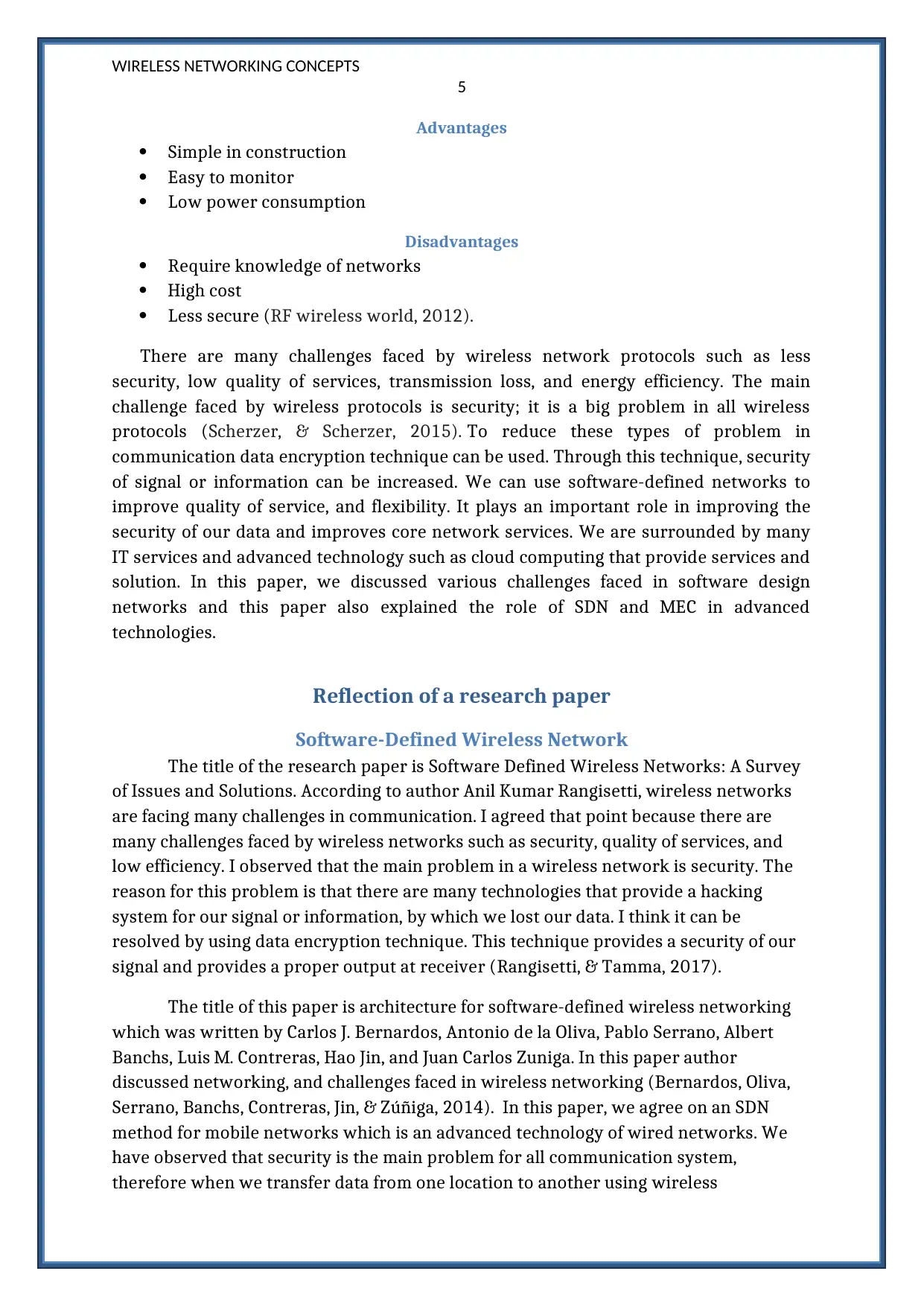
WIRELESS NETWORKING CONCEPTS
5
Advantages
Simple in construction
Easy to monitor
Low power consumption
Disadvantages
Require knowledge of networks
High cost
Less secure (RF wireless world, 2012).
There are many challenges faced by wireless network protocols such as less
security, low quality of services, transmission loss, and energy efficiency. The main
challenge faced by wireless protocols is security; it is a big problem in all wireless
protocols (Scherzer, & Scherzer, 2015). To reduce these types of problem in
communication data encryption technique can be used. Through this technique, security
of signal or information can be increased. We can use software-defined networks to
improve quality of service, and flexibility. It plays an important role in improving the
security of our data and improves core network services. We are surrounded by many
IT services and advanced technology such as cloud computing that provide services and
solution. In this paper, we discussed various challenges faced in software design
networks and this paper also explained the role of SDN and MEC in advanced
technologies.
Reflection of a research paper
Software-Defined Wireless Network
The title of the research paper is Software Defined Wireless Networks: A Survey
of Issues and Solutions. According to author Anil Kumar Rangisetti, wireless networks
are facing many challenges in communication. I agreed that point because there are
many challenges faced by wireless networks such as security, quality of services, and
low efficiency. I observed that the main problem in a wireless network is security. The
reason for this problem is that there are many technologies that provide a hacking
system for our signal or information, by which we lost our data. I think it can be
resolved by using data encryption technique. This technique provides a security of our
signal and provides a proper output at receiver (Rangisetti, & Tamma, 2017).
The title of this paper is architecture for software-defined wireless networking
which was written by Carlos J. Bernardos, Antonio de la Oliva, Pablo Serrano, Albert
Banchs, Luis M. Contreras, Hao Jin, and Juan Carlos Zuniga. In this paper author
discussed networking, and challenges faced in wireless networking (Bernardos, Oliva,
Serrano, Banchs, Contreras, Jin, & Zúñiga, 2014). In this paper, we agree on an SDN
method for mobile networks which is an advanced technology of wired networks. We
have observed that security is the main problem for all communication system,
therefore when we transfer data from one location to another using wireless
5
Advantages
Simple in construction
Easy to monitor
Low power consumption
Disadvantages
Require knowledge of networks
High cost
Less secure (RF wireless world, 2012).
There are many challenges faced by wireless network protocols such as less
security, low quality of services, transmission loss, and energy efficiency. The main
challenge faced by wireless protocols is security; it is a big problem in all wireless
protocols (Scherzer, & Scherzer, 2015). To reduce these types of problem in
communication data encryption technique can be used. Through this technique, security
of signal or information can be increased. We can use software-defined networks to
improve quality of service, and flexibility. It plays an important role in improving the
security of our data and improves core network services. We are surrounded by many
IT services and advanced technology such as cloud computing that provide services and
solution. In this paper, we discussed various challenges faced in software design
networks and this paper also explained the role of SDN and MEC in advanced
technologies.
Reflection of a research paper
Software-Defined Wireless Network
The title of the research paper is Software Defined Wireless Networks: A Survey
of Issues and Solutions. According to author Anil Kumar Rangisetti, wireless networks
are facing many challenges in communication. I agreed that point because there are
many challenges faced by wireless networks such as security, quality of services, and
low efficiency. I observed that the main problem in a wireless network is security. The
reason for this problem is that there are many technologies that provide a hacking
system for our signal or information, by which we lost our data. I think it can be
resolved by using data encryption technique. This technique provides a security of our
signal and provides a proper output at receiver (Rangisetti, & Tamma, 2017).
The title of this paper is architecture for software-defined wireless networking
which was written by Carlos J. Bernardos, Antonio de la Oliva, Pablo Serrano, Albert
Banchs, Luis M. Contreras, Hao Jin, and Juan Carlos Zuniga. In this paper author
discussed networking, and challenges faced in wireless networking (Bernardos, Oliva,
Serrano, Banchs, Contreras, Jin, & Zúñiga, 2014). In this paper, we agree on an SDN
method for mobile networks which is an advanced technology of wired networks. We
have observed that security is the main problem for all communication system,
therefore when we transfer data from one location to another using wireless
⊘ This is a preview!⊘
Do you want full access?
Subscribe today to unlock all pages.

Trusted by 1+ million students worldwide

WIRELESS NETWORKING CONCEPTS
6
networking than we lost the security of data. However to avoid this problem we can use
software-defined networking for a communication system. We have also discussed
different types of wireless networks and there advantages and disadvantages. So
according to my opinion, we can use wireless networks for communication but we
required a security plan for our data, information, and signal. For example, we can use
different techniques to improve security such as encryption techniques, in which we
make a particular code for information that transfers from one location to another using
transmitter and receiver circuits. So there are many techniques and technologies
through which we can improve the quality of our data.
6
networking than we lost the security of data. However to avoid this problem we can use
software-defined networking for a communication system. We have also discussed
different types of wireless networks and there advantages and disadvantages. So
according to my opinion, we can use wireless networks for communication but we
required a security plan for our data, information, and signal. For example, we can use
different techniques to improve security such as encryption techniques, in which we
make a particular code for information that transfers from one location to another using
transmitter and receiver circuits. So there are many techniques and technologies
through which we can improve the quality of our data.
Paraphrase This Document
Need a fresh take? Get an instant paraphrase of this document with our AI Paraphraser
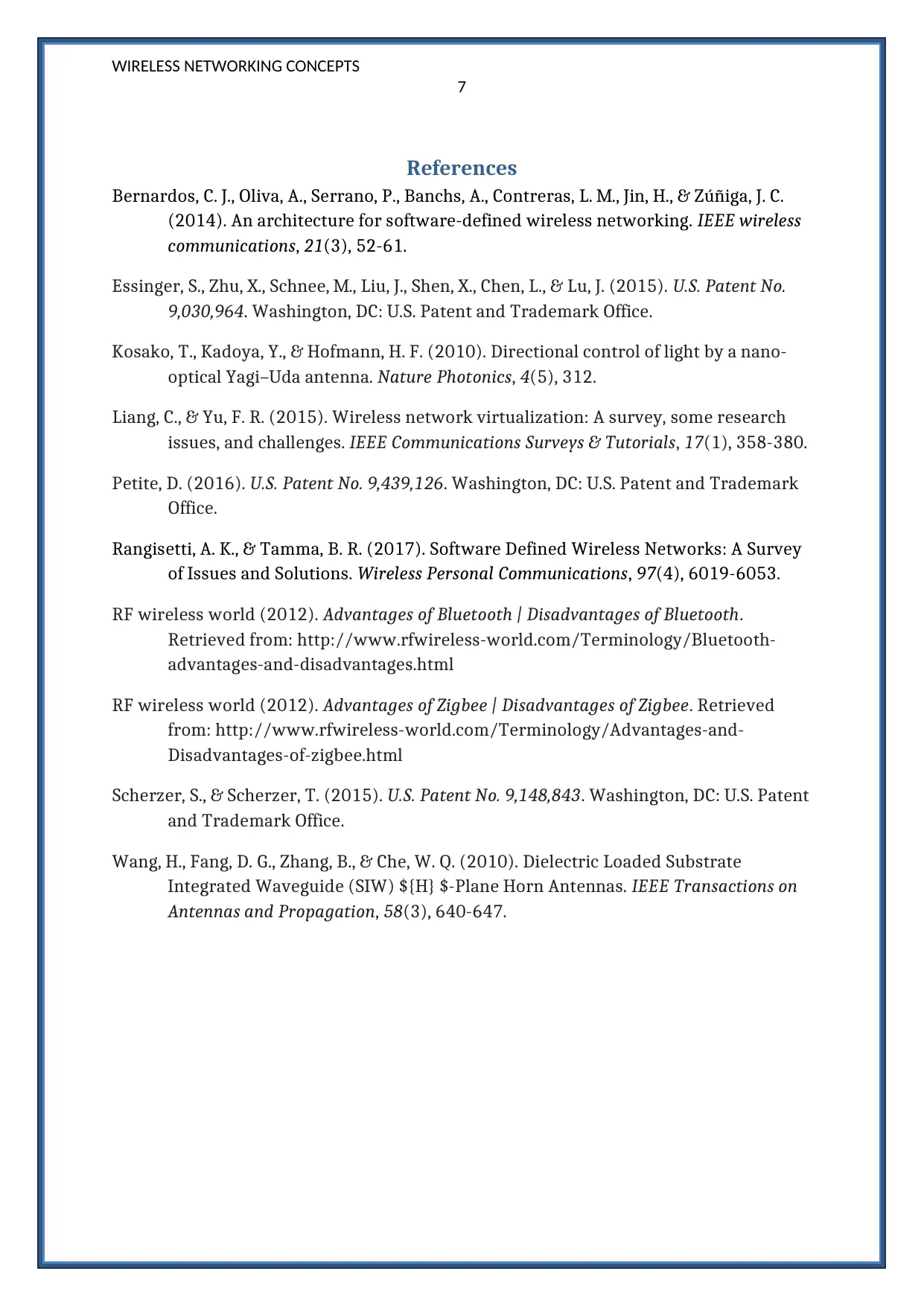
WIRELESS NETWORKING CONCEPTS
7
References
Bernardos, C. J., Oliva, A., Serrano, P., Banchs, A., Contreras, L. M., Jin, H., & Zúñiga, J. C.
(2014). An architecture for software-defined wireless networking. IEEE wireless
communications, 21(3), 52-61.
Essinger, S., Zhu, X., Schnee, M., Liu, J., Shen, X., Chen, L., & Lu, J. (2015). U.S. Patent No.
9,030,964. Washington, DC: U.S. Patent and Trademark Office.
Kosako, T., Kadoya, Y., & Hofmann, H. F. (2010). Directional control of light by a nano-
optical Yagi–Uda antenna. Nature Photonics, 4(5), 312.
Liang, C., & Yu, F. R. (2015). Wireless network virtualization: A survey, some research
issues, and challenges. IEEE Communications Surveys & Tutorials, 17(1), 358-380.
Petite, D. (2016). U.S. Patent No. 9,439,126. Washington, DC: U.S. Patent and Trademark
Office.
Rangisetti, A. K., & Tamma, B. R. (2017). Software Defined Wireless Networks: A Survey
of Issues and Solutions. Wireless Personal Communications, 97(4), 6019-6053.
RF wireless world (2012). Advantages of Bluetooth | Disadvantages of Bluetooth.
Retrieved from: http://www.rfwireless-world.com/Terminology/Bluetooth-
advantages-and-disadvantages.html
RF wireless world (2012). Advantages of Zigbee | Disadvantages of Zigbee. Retrieved
from: http://www.rfwireless-world.com/Terminology/Advantages-and-
Disadvantages-of-zigbee.html
Scherzer, S., & Scherzer, T. (2015). U.S. Patent No. 9,148,843. Washington, DC: U.S. Patent
and Trademark Office.
Wang, H., Fang, D. G., Zhang, B., & Che, W. Q. (2010). Dielectric Loaded Substrate
Integrated Waveguide (SIW) ${H} $-Plane Horn Antennas. IEEE Transactions on
Antennas and Propagation, 58(3), 640-647.
7
References
Bernardos, C. J., Oliva, A., Serrano, P., Banchs, A., Contreras, L. M., Jin, H., & Zúñiga, J. C.
(2014). An architecture for software-defined wireless networking. IEEE wireless
communications, 21(3), 52-61.
Essinger, S., Zhu, X., Schnee, M., Liu, J., Shen, X., Chen, L., & Lu, J. (2015). U.S. Patent No.
9,030,964. Washington, DC: U.S. Patent and Trademark Office.
Kosako, T., Kadoya, Y., & Hofmann, H. F. (2010). Directional control of light by a nano-
optical Yagi–Uda antenna. Nature Photonics, 4(5), 312.
Liang, C., & Yu, F. R. (2015). Wireless network virtualization: A survey, some research
issues, and challenges. IEEE Communications Surveys & Tutorials, 17(1), 358-380.
Petite, D. (2016). U.S. Patent No. 9,439,126. Washington, DC: U.S. Patent and Trademark
Office.
Rangisetti, A. K., & Tamma, B. R. (2017). Software Defined Wireless Networks: A Survey
of Issues and Solutions. Wireless Personal Communications, 97(4), 6019-6053.
RF wireless world (2012). Advantages of Bluetooth | Disadvantages of Bluetooth.
Retrieved from: http://www.rfwireless-world.com/Terminology/Bluetooth-
advantages-and-disadvantages.html
RF wireless world (2012). Advantages of Zigbee | Disadvantages of Zigbee. Retrieved
from: http://www.rfwireless-world.com/Terminology/Advantages-and-
Disadvantages-of-zigbee.html
Scherzer, S., & Scherzer, T. (2015). U.S. Patent No. 9,148,843. Washington, DC: U.S. Patent
and Trademark Office.
Wang, H., Fang, D. G., Zhang, B., & Che, W. Q. (2010). Dielectric Loaded Substrate
Integrated Waveguide (SIW) ${H} $-Plane Horn Antennas. IEEE Transactions on
Antennas and Propagation, 58(3), 640-647.
1 out of 8
Related Documents
Your All-in-One AI-Powered Toolkit for Academic Success.
+13062052269
info@desklib.com
Available 24*7 on WhatsApp / Email
![[object Object]](/_next/static/media/star-bottom.7253800d.svg)
Unlock your academic potential
Copyright © 2020–2025 A2Z Services. All Rights Reserved. Developed and managed by ZUCOL.





